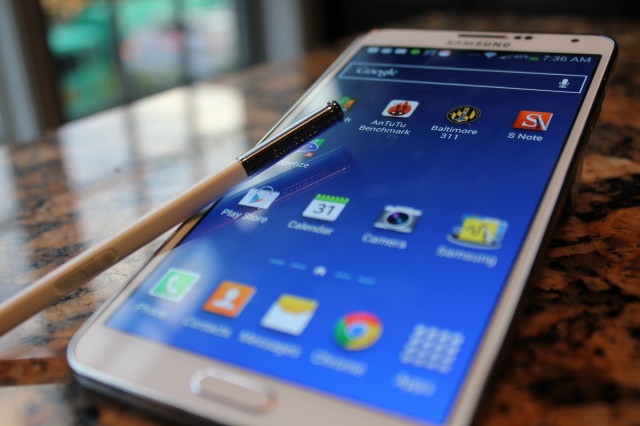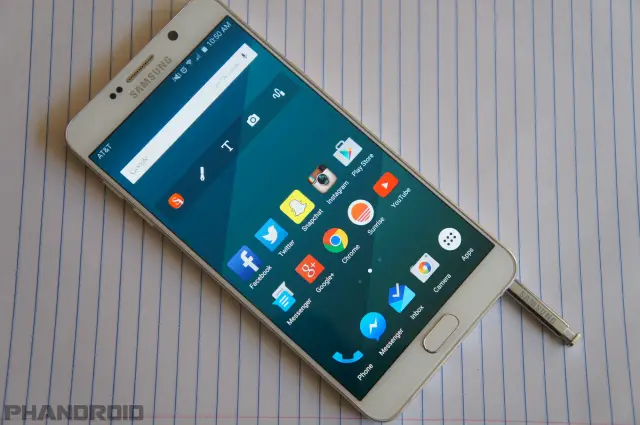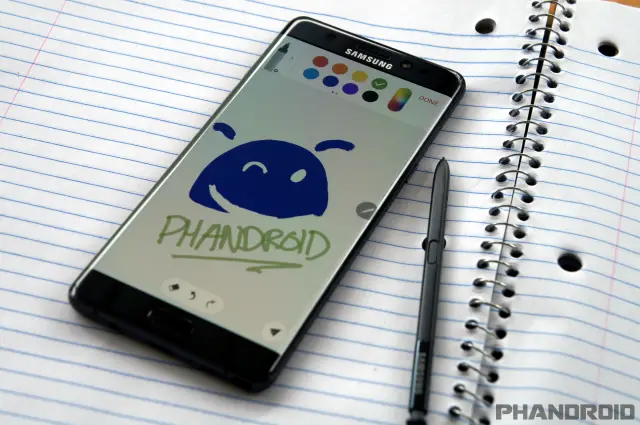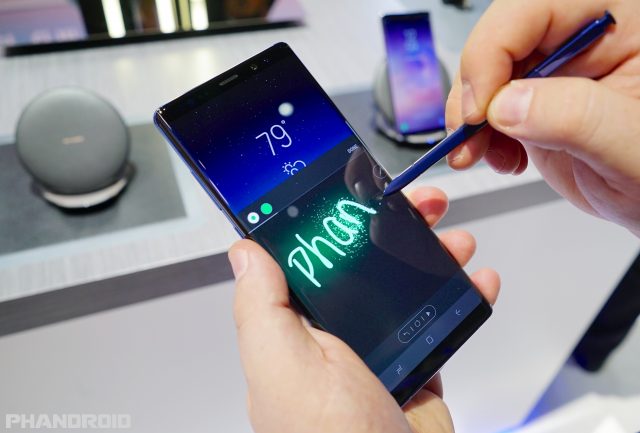Baca Juga
Samsung has a long history of Android devices that showcase just how quickly we move forward in tech from year to year. The original Galaxy Note debuted six years ago and since then, we’ve seen a progressive change to each Galaxy Note phone that has come afterward. Samsung certainly hasn’t rested on their laurels and the most recent phone, the Galaxy Note 8, stands on the shoulders of giants.
Let’s take a look.
Samsung Galaxy Note
Launch Date: October 29, 2011
Specs:- 5.3-inch AMOLED display with 800 x 1280 resolution (285 PPI)
- Qualcomm Snapdragon S3
- 1.5 GHz dual-core Qualcomm Scorpion APQ8060
- Qualcomm Adreno 220
- 1GB of RAM
- 16/32 GB flash memory
- microSD card slot (up to 64GB)
- 2500 mAh battery
- 8-megapixel rear camera
- 2-megapixel front camera
The start of the phablet craze can be traced squarely to the feet of this phone, the Samsung Galaxy Note. While downright tiny by today’s standards, it’s 5.3-inch screen made waves for being sized between the Samsung Galaxy S II and the Galaxy Tab 7.0 that debuted the same year.
The Galaxy Note launched with Android 2.3 Gingerbread and was eventually upgraded to Android 4.1.2 Jellybean before Samsung finally dropped support for the phone. Third party ROM makers have gotten Android 7.1.1 Nougat running on the device, so despite the hardware showing its age, the Galaxy Note is still chugging along.
Part of the appeal of the Galaxy Note series is the inclusion of the S-Pen, which gave users precise handwriting control and note taking capabilities that just wasn’t common in phones before its time.
Sold: 10 million since 2012
Samsung Galaxy Note 2
Launch Date: September 26, 2012
Specs:- 5.5-inch Super AMOLED display with 1280 x 720 resolution (265 PPI)
- Qualcomm Snapdragon 600
- 1.6 GHz quad-core Cortex-A9
- ARM Mali-400MP4
- 2GB RAM
- 16/32/64 GB ROM
- microSD up to 64 GB
- 3,100 mAh removable battery
- 8MP rear camera
- 1.9MP front facing camera
Building on the popularity of the Galaxy Note line, Samsung and within the first 37 days of availability, Samsung sold 3 million units. Within two months, Samsung sold 5 million Galaxy Note II devices.
The Galaxy Note II launched with Android 4.1.1 Jelly Bean and was eventually upgraded to Android 4.4.2 KitKat before Samsung dropped support. The phone was available in a including Titanium Grey, Marble White, Martian Pink, Amber Brown, and Ruby Wine.
Sold: 30 million since September 2013
Launch Date: September 25, 2013
Specs:- 5.7-inch Super AMOLED display with 1920 x 1080 resolution (388 PPI)
- 2.3 GHz quad-core Qualcomm Snapdragon 800 processor
- Adreno 330 GPU
- 3GB RAM
- 16/32/64 GB ROM
- microSDXC up to 256 GB
- 3,200 mah removable battery
- 13-megapixel rear camera
- 2-megapixel front camera
Samsung went a new direction with the design of the with the intention of making the phone seem more premium than the previous plastic-backed generations. This time they went with a faux leather stitched back and a metal frame that received some criticism for its design at a time when other manufacturers were beginning to feature all glass backs.
The phone was the before Samsung dropped support. It was the first smartphone to include support for USB 3.0 and when it launched it was only available in black, white, and pink. Samsung later introduced three new colors including black with gold trim, white with rose gold trim, and red with silver trim.
Some of the S-Pen improvements that came with the Galaxy Note 3 line include a new and more multi-window functionality that could be controlled with the stylus.
Sold: 5 million in first month, 10 million in 2 months
Launch Date: October 17, 2014
Specs:- 5.7-inch Super AMOLED display with 2560×1440 resolution (518 PPI)
- 2.7Ghz Quad-core Qualcomm Snapdragon 805
- Adreno 420 GPU
- 3GB RAM
- 32 GB storage
- microSDXC up to 128 GB
- 3,220 mAh removable battery
- 16-megalpixel rear camera
- 3.7-megapixel front camera
The built on the success of the Galaxy Note 3 line, though it took a few steps backward in some cases. While the Galaxy Note 3 supported USB 3.0, the Galaxy Note 4 only included USB 2.0 support thanks to a new feature called Fast Charge. Samsung said Fast Charge could charge the device from 0% to 50% in about 30 minutes.
The Galaxy Note 4 also included a wide variety of sensors that weren’t available on other phones, including a UV sensor, heart-rate monitor, and oximeter. Samsung also touted new features for the S-Pen including tilt and rotation recognition, but support for them was never included on the Galaxy Note 4. The .
There was also an edge variant called the that eventually paved the way for the Galaxy S6 Edge and future edge phones. While it didn’t perform as well as the Galaxy Note 4 in sales, Samsung never intended the Galaxy Note Edge to be a full-fledged worldwide release. Instead, the phone was only sold in select markets as a limited edition release.
Sold: 4.5 million in first month
Launch Date: August 21, 2015
Specs:- 5.7-inch Super AMOLED display with 2560 x 1440 resolution (515 PPI)
- 64-bit Octa-Core Samsung Exynos 7420
- Mali-T760 MP8 GPU
- 4GB RAM
- 32, 64, or 128 GB storage
- 3,000mAh non-removable battery
- no MicroSD slot
- Fingerprint reader
The was meant to be a refined Galaxy Note 4 in a lot of ways, but Samsung removed a lot of essential features that made some die-hard fans of the Note series unhappy. This was the first smartphone in the Galaxy Note line to feature a non-removable battery and no microSD card for expandable storage. This led to widespread criticism of Samsung and the Galaxy Note 5, which up until now had been marketed toward mobile power users.
The Galaxy Note 5 had its own little minor scandal when it was discovered that the S-Pen could be inserted backward into the Galaxy Note 5, resulting in permanent damage and .
At launch, the Galaxy Note 5 ran Android 5.1.1 Lollipop. It has been and that will be the last OS update for the Note 5 from Samsung.
Sold: Couldn’t find any definitive sales numbers released by Samsung
Launch Date: August 19th, 2016
Specs:- 5.7-inch Super AMOLED display with 2560 x 1440 resolution (518 PPI)
- Qualcomm Snapdragon 820
- Adreno 530 GPU
- 4GB RAM
- 64 GB storage
- microSDXC up to 256 GB
- 3,500 mAh non-removable battery
- Rear Camera – Sony Exmor R IMX260 12 MP, f/1.7 aperture with fast Dual autofocus Technology, 4K video recording at 30 fps, 1080p at 60 fps, 720p at 240 fps
- 5-megapixel front camera
The Samsung Galaxy Note 7 was poised to bring the flagging Galaxy Note line back to the center of attention by fixing a lot of complaints users had about the Galaxy Note 5. It featured a microSD card slot and a much bigger battery, which ultimately resulted in the Galaxy Note 7 being recalled.
After several reports of .
Overall, the Galaxy Note 7 was a gorgeous phone with a very sleek design, but Samsung’s rush to beat Apple to market with the iPhone 7 led to a .
Sold: estimated 2.5 million before recall
Launch Date: August 23, 2017
Specs:- 6.3-inch Super AMOLED display with 2960 x 1440 resolution (521 PPI)
- Octa-core Qualcomm Snapdragon 835
- Adreno 540 GPU
- 64 GB storage in North America, 64, 128 or 256 GB storage globally
- 6GB RAM
- microSDXC expandable up to 256 GB
- 3,300mAh non-removable battery
- Dual 12-megapixel rear camera (wide angle + telephoto)
- 8-megapixel front camera
Whereas the Galaxy Note line used to inspire the direction the Galaxy S line headed, the opposite is now true. The to feature a dual-lens camera system and 6GB of RAM.
The phone’s 6.3-inch Infinity Display is just a touch bigger than the Galaxy S8+. The feature a 12MP wide-angle lens with f/1.7 aperture and a 12MP telephoto lens with a f/2.4 aperture.
Samsung made the decision to include the of the Galaxy Note 8 just like the Galaxy S8. Previous rumors before the phone was released suggested that Samsung might incorporate a fingerprint sensor directly into the display. The phone also features an iris scanner, USB-C port, and a 3.5 mm headphone jack, which is a starting to become a rare sight.
- http://www.duxducis.com/wp-content/uploads/2019/07/samsung-galaxy-note-10-plus-flip-case-5.jpg


- Samsung Galaxy Note series, samsung galaxy note series price in saudi arabia, samsung galaxy note series mobile,

.png)






